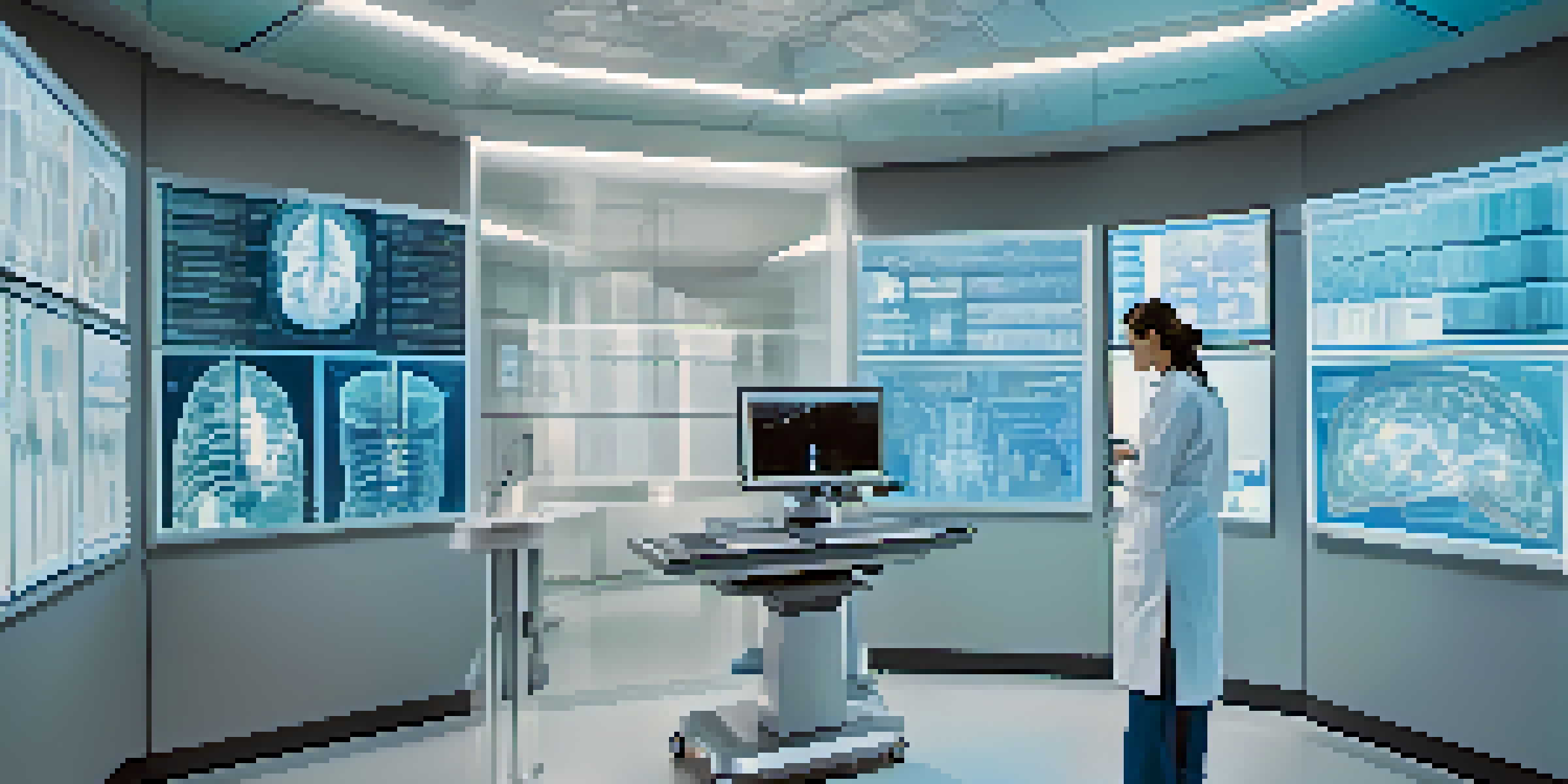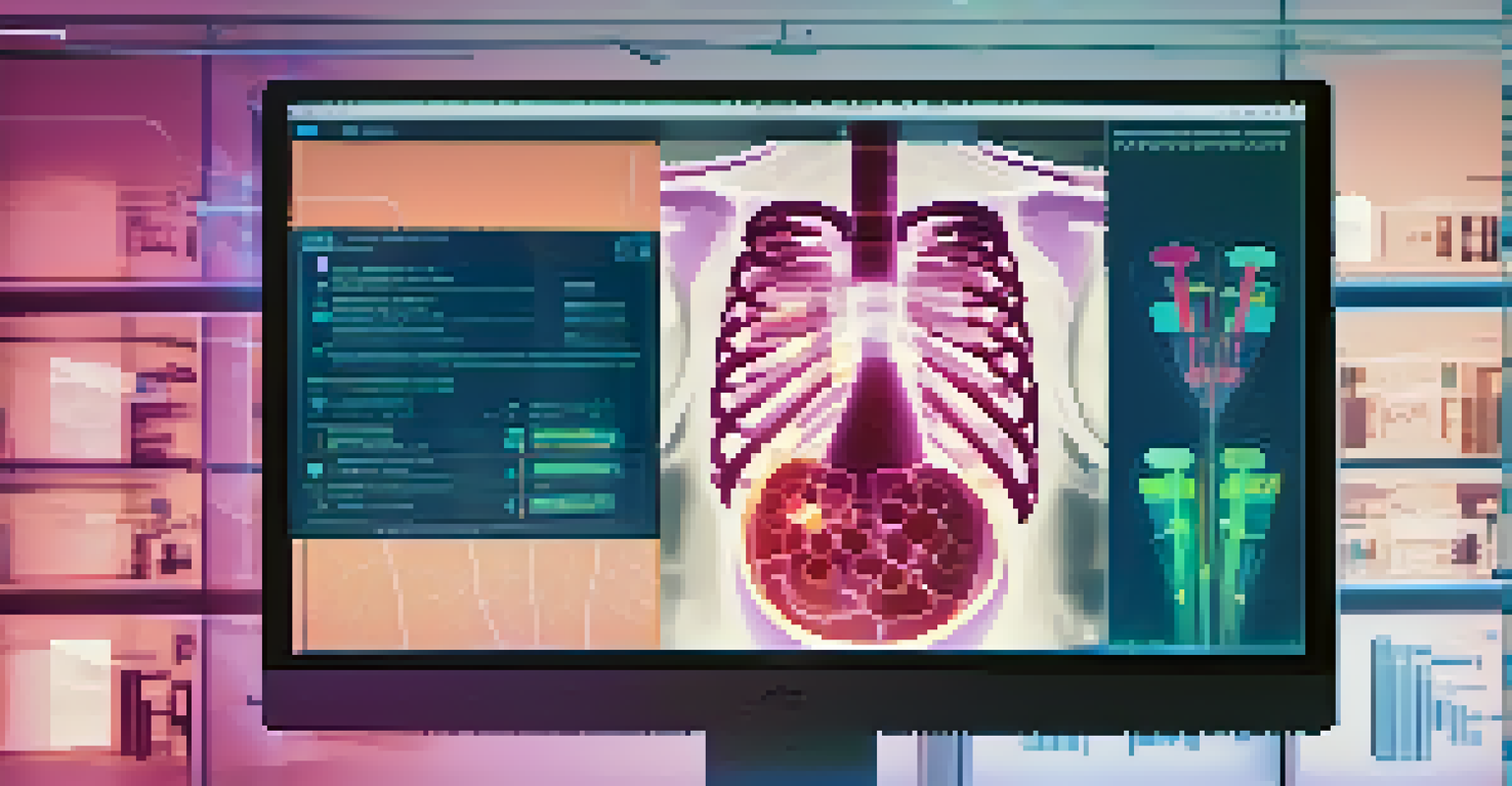AI in Imaging: Enhancing Accuracy in Diagnostics

Understanding AI in Medical Imaging and Diagnostics
Artificial Intelligence (AI) is revolutionizing medical imaging by improving diagnostic accuracy. By analyzing vast amounts of medical data, AI algorithms can identify patterns that may escape the human eye. This technology is particularly beneficial in radiology, where images can be complex and nuanced.
The future of medicine will be determined by the ability to integrate artificial intelligence into the diagnostic process.
For instance, AI can assist radiologists in detecting abnormalities in X-rays or MRIs, often leading to earlier and more accurate diagnoses. The integration of AI into imaging processes not only enhances the precision but also streamlines workflows, enabling healthcare professionals to focus more on patient care.
Moreover, as AI continues to evolve, its potential applications in diagnostics are expanding. From identifying tumors to detecting fractures, the impact of AI in medical imaging is both profound and far-reaching.
AI Algorithms: The Backbone of Enhanced Imaging Accuracy
At the heart of AI in imaging are sophisticated algorithms designed to analyze images with remarkable accuracy. These algorithms use deep learning techniques, a subset of machine learning, to learn from thousands of annotated images. This enables them to recognize patterns and anomalies that are critical for accurate diagnosis.

For example, convolutional neural networks (CNNs) are often employed in analyzing medical images. They mimic the way humans process visuals, allowing for detailed examination of images and improving the detection rates of conditions like cancer or pneumonia.
AI Enhances Diagnostic Accuracy
Artificial Intelligence improves diagnostic precision by analyzing medical images to detect patterns that may be missed by human eyes.
As these algorithms are trained on diverse datasets, they become increasingly adept at distinguishing between normal and abnormal findings. This not only enhances diagnostic confidence but also supports clinical decision-making, ultimately leading to better patient outcomes.
Real-World Applications of AI in Imaging
AI's real-world applications in imaging are not just theoretical; they are actively transforming healthcare. In radiology departments worldwide, AI tools are being used to analyze chest X-rays to detect signs of COVID-19, reducing the time taken for diagnosis during critical situations.
AI will augment human intelligence, not replace it, especially in areas like healthcare where human insight is vital.
Additionally, AI-powered platforms can flag urgent cases, enabling radiologists to prioritize their workloads effectively. This is particularly crucial in emergency settings where every second counts, and timely intervention can save lives.
Moreover, these applications extend beyond radiology. In fields like pathology and dermatology, AI is being utilized to analyze tissue samples and skin lesions, providing pathologists and dermatologists with enhanced diagnostic capabilities.
The Role of Data Quality in AI Imaging Solutions
The effectiveness of AI in medical imaging heavily relies on the quality of data used for training algorithms. High-quality, diverse datasets are essential for teaching AI systems to recognize a wide array of conditions accurately. Without this, the potential for misdiagnosis increases, which can have serious implications for patient care.
Healthcare institutions are increasingly focused on curating comprehensive datasets that include various demographics and clinical conditions. This approach not only improves the algorithm's accuracy but also ensures that AI solutions are equitable and effective across different populations.
Data Quality is Crucial
High-quality, diverse datasets are essential for training AI algorithms to ensure accurate and equitable medical imaging solutions.
Furthermore, continuous updates and assessments of these datasets are vital as new medical knowledge and diagnostic criteria emerge. This commitment to data quality is what enables AI imaging solutions to remain relevant and reliable in the fast-evolving field of healthcare.
Challenges in Implementing AI in Imaging Diagnostics
Despite the clear benefits, implementing AI in imaging diagnostics is not without its challenges. One significant hurdle is the integration of AI systems into existing healthcare workflows. Many facilities face resistance to change, as staff may be hesitant to adopt new technologies.
Additionally, concerns about data privacy and security are paramount. With sensitive patient information involved, healthcare providers must ensure that AI systems comply with regulations and protect patient confidentiality. This is crucial for building trust between patients and healthcare systems.
Moreover, there's the challenge of ensuring that AI tools are interpretable and transparent. Clinicians need to understand how AI arrives at its conclusions to make informed decisions about patient care. Addressing these challenges is essential for the successful adoption of AI in imaging diagnostics.
Future Trends in AI and Medical Imaging
Looking ahead, the future of AI in medical imaging is promising and full of potential advancements. One emerging trend is the use of AI to facilitate personalized medicine, where imaging can guide tailored treatment plans based on individual patient characteristics.
Furthermore, the integration of AI with other technologies, such as augmented reality (AR) and virtual reality (VR), is on the horizon. These innovations could enhance the visualization of complex imaging data, aiding in surgical planning and education.
AI Faces Implementation Challenges
Integrating AI into existing healthcare workflows poses challenges, including resistance to change and concerns about data privacy.
As research continues and AI technology evolves, we can expect even greater accuracy and efficiency in medical imaging diagnostics. This not only has the potential to improve patient outcomes but also to reshape the future of healthcare as we know it.
The Impact of AI on Patient Outcomes and Healthcare Quality
The impact of AI in imaging is ultimately measured by its effect on patient outcomes and the overall quality of healthcare. By enhancing diagnostic accuracy, AI tools can lead to earlier interventions and better treatment pathways, significantly improving patient prognosis.
Moreover, the efficiency gained through AI integration allows healthcare providers to devote more time to patient interactions and care decisions. This shift can enhance patient satisfaction and trust in the healthcare system, fostering a more positive experience.

Additionally, as AI continues to evolve, we can expect its role in healthcare to expand, offering new solutions to longstanding challenges. The continued focus on improving diagnostic accuracy through AI will undoubtedly lead to a healthier future for all.